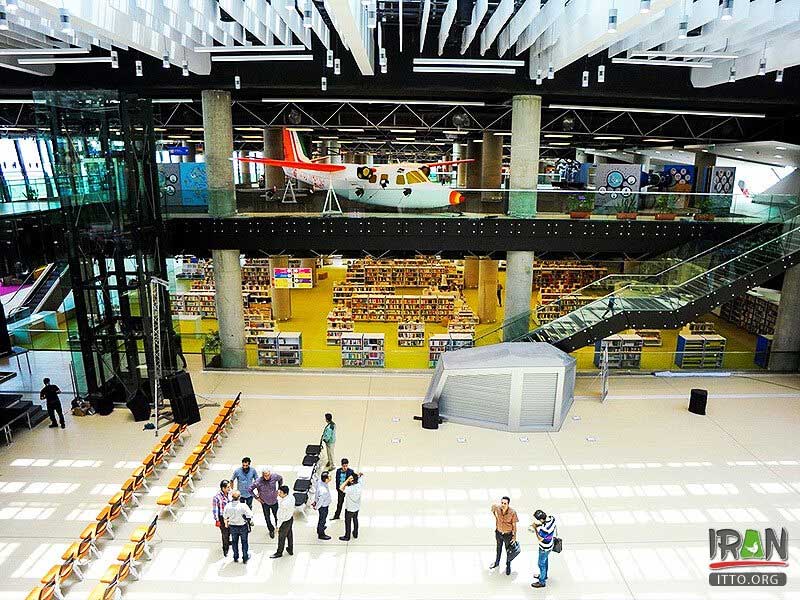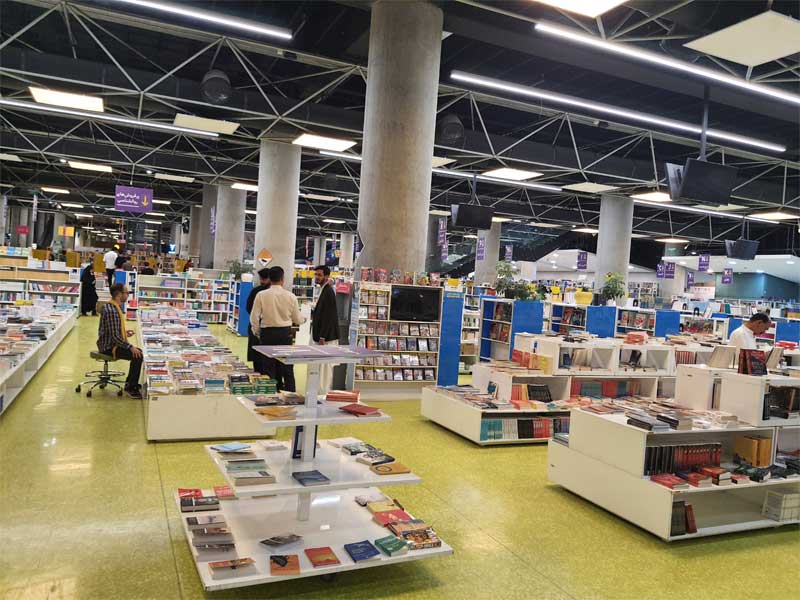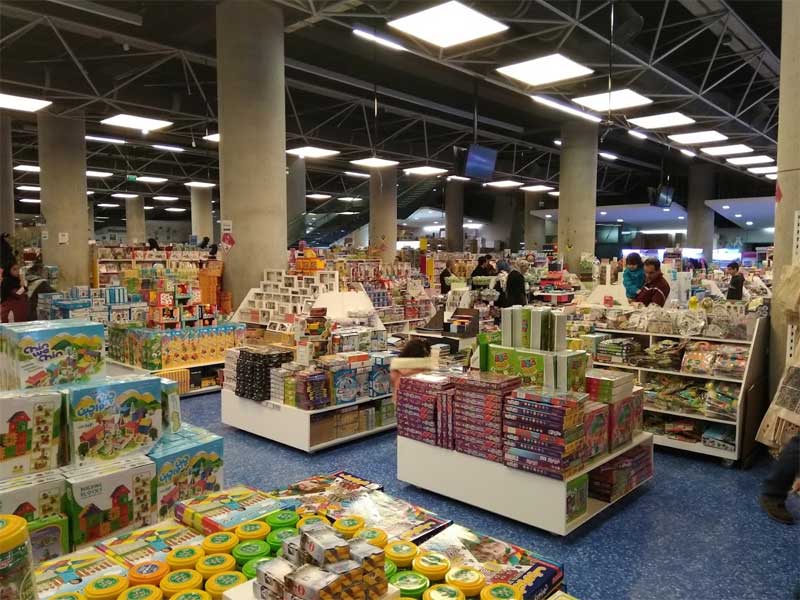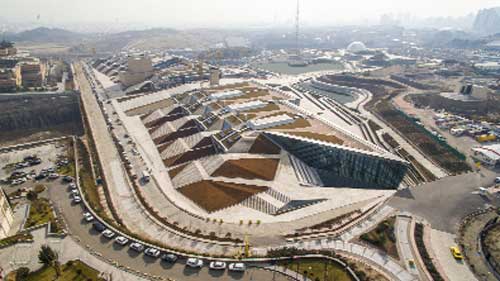

After our incredible visit to the Islamic Revolution Museum in Tehran, our next destination was the Book Garden of Tehran, an exciting and amazing bookstore.
Tehran, the bustling and vibrant capital of Iran, has long been known for its rich cultural heritage, and in recent years, it has added a new jewel to its crown – Tehran’s Book Garden. This extraordinary cultural center, which opened its doors in 2017, has quickly become a symbol of the enduring love for literature and culture in Iran, offering a haven for book enthusiasts and a celebration of the country’s literary legacy.

A Cultural Haven in the Heart of Tehran
Tehran Book Garden, known as “Baqh-e Ketab” in Persian, is a unique and awe-inspiring urban space that had long been yearned for by millions of residents and thousands of students in Tehran. It’s more than just a building; it’s a cultural and dynamic atmosphere that has not only opened a window to wisdom but has also become a defining feature of Tehran’s identity. The Book Garden has garnered positive feedback on an international scale, and its appeal transcends boundaries.
A Place for Everyone
Tehran Book Garden caters to a diverse range of interests and needs. Whether you’re a bibliophile, a dedicated student, a parent seeking a serene environment with amenities for children, or just someone looking for a unique and enriching afternoon experience, the Book Garden has something to offer.
A Permanent Hub for Literary and Cultural Enthusiasts
Prior to the emergence of the Tehran Book Garden, the Tehran International Book Fair was the primary event for book enthusiasts in the city. However, this fair, although immensely popular and influential, was a temporary event. The Book Garden, on the other hand, was conceived as a long-term solution to meet the constant demand for cultural products, particularly books, among the residents of the capital.
A Multi-Year Project of Dedication
The Tehran Book Garden is the result of a multi-year project, situated in the hills of Abbasabad, adjacent to the National Library of Iran. This ambitious endeavor required years of dedicated effort and planning to create a dynamic urban space that would cater to the needs of the well-read and those seeking cultural enrichment.
A Hub of Learning and Exploration
The Tehran Book Garden not only houses an extensive collection of books but also provides a welcoming environment for learning and exploration. Its modern architecture and serene surroundings make it an ideal place for individuals of all ages to immerse themselves in the world of literature and knowledge. With reading corners, research facilities, and spaces for workshops and events, it fosters a culture of continuous learning and intellectual engagement.
Promoting Cultural Exchange
In addition to its local significance, the Tehran Book Garden has also played a role in promoting cultural exchange on an international level. It has hosted numerous events, exhibitions, and literary gatherings that have attracted visitors and scholars from around the world, further cementing its position as a global cultural hub.
Tehran’s Book Garden is not just a physical space; it is a testament to Iran’s enduring passion for literature and culture. It stands as a symbol of the country’s commitment to nurturing intellectual curiosity, fostering a love for books, and providing a space where people of all backgrounds can come together to explore the world of knowledge. As it continues to evolve and thrive, the Tehran Book Garden remains a literary oasis in the heart of Iran’s bustling capital, enriching the lives of its residents and leaving an indelible mark on the cultural landscape of the region.
A Celebration of Literature
Tehran’s Book Garden is more than just a library or bookstore; it’s a multifaceted cultural complex that encapsulates the essence of Iranian literature and art. The facility spans a massive 65,000 square meters and is designed to resemble an open book. With its unique architectural design and lush green spaces, it invites visitors to explore its treasures and engage in a literary journey. The sprawling gardens are adorned with sculptures of renowned Persian poets, adding an artistic touch to the environment and serving as a reminder of Iran’s rich poetic tradition, which has produced luminaries like Hafez, Rumi, and Saadi.

A Vast Collection
One of the most remarkable features of Tehran’s Book Garden is its extensive collection of books. The library houses over one million books, making it one of the largest in Iran. The collection covers a wide array of topics, including literature, history, philosophy, science, and art, ensuring that there is something for everyone. Whether you’re a scholar seeking rare manuscripts or a casual reader looking for a novel, you’ll find it here. The library also boasts a special section dedicated to rare and ancient manuscripts, providing a glimpse into Iran’s literary heritage and history.
Cultural Activities
Tehran’s Book Garden is not merely a static repository of books; it’s a vibrant hub of cultural activities. The complex hosts numerous events, seminars, book launches, and exhibitions throughout the year. These events often feature prominent authors, scholars, and artists, fostering intellectual discourse and creativity. One of the highlights of the cultural calendar is the Tehran International Book Fair, held annually at the Book Garden, drawing publishers, writers, and book enthusiasts from all over the world and solidifying Tehran’s status as a global literary destination.
A Space for Creativity
The Book Garden encourages creativity and artistic expression. It houses a dedicated area for artists to showcase their work and a section for children to explore literature through interactive exhibits and activities. The emphasis on nurturing young minds underscores the commitment to passing on Iran’s literary and cultural legacy to future generations.

Tehran’s Book Garden is more than a library; it’s a cultural treasure that embodies Iran’s profound appreciation for literature and knowledge. With its vast collection, artistic ambiance, and commitment to fostering creativity, it stands as a symbol of Iran’s enduring cultural identity. In a world that often moves at a frenetic pace, the Book Garden serves as a reminder of the timeless value of books, art, and the written word. Whether you’re a visitor or a local, a scholar or a casual reader, Tehran’s Book Garden is an oasis of inspiration and a testament to the enduring power of literature.
Now please find below the English translation of the Urdu write-up by Mr. Nazir Leghari:
A garden of books spanning 7 lakh square feet in Tehran.
Reza Shabanis, coming out of the revolution and defense, inquire about exhaustion from us. We replied that we have come to see Iran; we haven’t come to relieve exhaustion. They say that from here, we walk towards the “Garden of Books.” Now, as we walk, we emerge from the surroundings of the revolution and war onto a peaceful path. On our right side, there is a garden of grass, plants, flowers, ponds, fountains, lakes, and fragrances. On the left, there is a wall entirely covered by various types of vines. In the garden on the right, people are strolling leisurely. There is no crowd, no noise, no commotion, no voices of vendors selling food and drink, no cries of hungry, screaming children. These are not the tired, unjustly beaten, and politically imprisoned people of society. These are people who have passed through the experience of a revolution and emerged from the stones to the paths of life. We are the people who, tired from chasing mirages of dreams throughout our lives, have finally rested. So, when we see such gardens, our yearnings awaken.
We arrive at a square where various locations are marked. The Garden of Arts, the Garden of Exhibits, the Daryacheh River, and the Museum of the Sacred Defense are behind us. While the Garden of Books, the Garden of Food, and the National Library are ahead, guiding us. We continue forward.
The Garden of Books is established on a seven million square feet area. Here, hundreds of thousands of books on various subjects, themes, sciences, and arts are displayed. Reza Shabani explains that the concept of the Garden of Books emerged continuously from the book fairs in 2004. Book fairs were held every year in Tehran, where a large number of people participated, expressing their interest in books on various subjects. Such book fairs took place at different times on different occasions, with the International Book Fair being the center of people’s special attention. The citizens of Tehran eagerly awaited this global book fair every year.
The Garden of Books is a place where there are four hundred thousand different books for children alone. Don’t think that there are just four hundred thousand books in general for children; there are more than four hundred thousand books specifically designed for children. It should be noted that according to Guinness Book Records, until 1999, the world’s largest individual book store was Barnes & Noble on Fifth Avenue in New York, spread over an area of 154,000 square feet. And you already know that the Garden of Books in Tehran is spread over seven million square feet.
We enter the Garden of Books. Oveis Rabani takes us to the distant gardens of books, and Zein Naqvi is walking alongside them. I walk with Manzar Naqvi and Reza Shabani, strolling comfortably among the shelves of books on various sciences. It’s a unique experience of life. Here, book buyers carry trolleys full of books, selecting books from shelves as if they are shopping for groceries or other essential items at a department store.
Thousands of racks are housing books, revealing their knowledge. People discuss the books they’re about to buy with the sellers. Images of Iranian poets, scientists, scholars, photographers, artists, workers, writers, and authors hang on the walls and in the open air. Different books from various fields are displayed here-poetry, novels, stories, essays, science, science fiction, mathematics, physics, chemistry, medicine, engineering, philosophy, economics, politics, archaeology, astronomy, astrophysics, poetry, sonnets, parables, epics, and other literary, scientific, social, and jurisprudential subjects are represented in separate sections. Here, Mir Anis comes to mind, “I am amazed at what I see with my two eyes.”
If this book is measured in acres within the garden, it covers 37 acres. In terms of square meters, it spans 65,000 square meters in the metropolis. On the rooftop of its three-story building, there is a 25,000 square meter garden. This book garden is divided into 13 separate blocks, each block with its own unique attraction. Yellow carpets have been laid on the floor, which don’t burden the mind. In some places, the carpet has been left as it is, maintaining its original texture.
On the top floor, there are study areas for university students, where individual cabins are equipped with tables, chairs, and digital tools, including computers and other equipment. Students are engaged in both group and individual studies in these cabins.
I proceed with Mr. Manzar Naqvi towards the relaxation area with books. My guide, Rumi, catches my eye. Meanwhile, Frederick Nietzsche’s Zarathustra aspires to enlighten us with his eloquent sentences. Alongside, Kimia’s book “Alchemy and Mystery” eagerly awaits uncovering new secrets. In a similar vein, D.H. Lawrence’s “Sons and Lovers” extends an invitation to explore.
In this place, millions of books in Arabic, Persian, English, French, German, and other languages are fulfilling a special academic obligation in Iran. Economists in our country are worried about low income levels, but here in Iran, experts are working diligently to increase literacy rates.
This Book Garden is emerging as a significant cultural and educational center in Tehran. It is called “Bagh-e-Baharistan” in Block A, a special place for young children and teenagers. Sculptures of cartoon characters are placed here, bringing joy to the children. Block B is Carefree Lane, a 60-meter-long walkway where pedestrians are presented with images and videos on powerful projectors on both sides. Block C is Sarvestan, which houses 11 cinemas and theaters. There is also an art shop, and Science Garden for children aged seven to twelve.
The blog of this Book Garden is called D. Sarvestan. It is a store for books and cultural items. The rooftop of the Book Garden has cafes, restaurants, and the lush greenery of the garden. We explore the Book Garden in the world of knowledge, but no corner can be considered the last one. Owais Rabbani complains that not even a single book in Urdu is present in the largest book garden in the world, let alone Iqbal’s Bang-e-Dra, Bal-e-Jibril, Asrar-e-Khudi, or Zarb-e-Kalim.
Here, there are books in Azerbaijani, Armenian, Uzbek, and Tajik languages, but why not in Urdu? Owais Rabbani has extensive knowledge of Iqbal and is well-acquainted with Allama Iqbal, also known as Iqbal Lahori, but there is no Urdu or Persian diwan of Iqbal in this Book Garden. Owais Rabbani wishes to formally register his complaint with the administration of the Book Garden through Reza Shabani.
Today, in Iran, the first day has ended, and the first sunset of the sun has taken place. The first hour of the night has begun. Reza Shabani recommends walking to the hotel, but we insist on using the travel car to reach the hotel. Even reaching the car involves quite a distance. When the car departs for the hotel, it covers such a distance that if we had walked, we would have reached the hotel in the middle of the night. In any case, we arrive at the hotel and have dinner. Then, we head to our respective rooms.

Summary of First Day Activates
On Sunday July 9, 2013,morning we had reached Tehran with the courtesy of Iranian Cultural Center and spent all the day with full of activities and tired very much, tomorrow on Monday we will again resumed new activities in Tehran. Today we explored Milad Tower, Aab o Aatish Park, Tabiat Bridge, Museum of Islamic Revolution, and Books Garden of Tehran.


